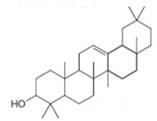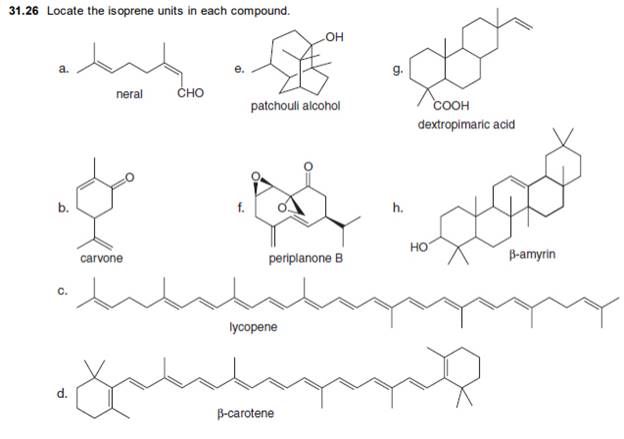
ORG CHEM CONNECT CARD
6th Edition
ISBN: 9781264860746
Author: SMITH
Publisher: MCG
expand_more
expand_more
format_list_bulleted
Concept explainers
Textbook Question
Chapter 29, Problem 26P
Locate the isoprene units in each compound.
a.  e.
e.  g.
g. 
neral patchouli alcohol dextropimaric acid
b.  f.
f.  h.
h.
carvone periplanone B
c. 
d. 

Expert Solution & Answer
Want to see the full answer?
Check out a sample textbook solution
Students have asked these similar questions
1) How many monochlorination products-including stereochemistry- are there for the molecule below:
Select an amino acid that has and N-H or O-H bond in its R-group (you have 8 to choose from!). Draw at least two water molecules interacting with the R-group of the amino acid.
Is this aromatic?
Chapter 29 Solutions
ORG CHEM CONNECT CARD
Ch. 29.2 - Problem 31.1
One component of jojoba oil is a wax...Ch. 29.3 - Problem 31.2
How would you expect the melting...Ch. 29.3 - Problem 31.3
Draw the products formed when...Ch. 29.3 - Problem 31.4
The main fatty acid component of the...Ch. 29.3 - Prob. 5PCh. 29.7 - Problem 31.10
Locate the isoprene units in each...Ch. 29.7 - Problem 31.11
Locate the isoprene units in...Ch. 29.7 - Problem 31.12
Write a stepwise mechanism for the...Ch. 29.7 - Prob. 14PCh. 29.8 - Prob. 15P
Ch. 29.8 - Prob. 16PCh. 29.8 - Prob. 17PCh. 29 - 31.17 Locate the isoprene units in each...Ch. 29 - Prob. 25PCh. 29 - Locate the isoprene units in each compound. a. e....Ch. 29 - 31.27 Classify each terpene and terpenoid in...Ch. 29 - Prob. 33PCh. 29 - Draw three-dimensional structures f or each...Ch. 29 - Prob. 37PCh. 29 - Prob. 38PCh. 29 - Prob. 39PCh. 29 - Prob. 40PCh. 29 - 31.38 Draw the products formed when cholesterol is...Ch. 29 - 31.39 Draw a stepwise mechanism for the following...Ch. 29 - 31.40 Draw a stepwise mechanism for the following...Ch. 29 - Prob. 44P
Knowledge Booster
Learn more about
Need a deep-dive on the concept behind this application? Look no further. Learn more about this topic, chemistry and related others by exploring similar questions and additional content below.Similar questions
- CHEM2323 E Tt PS CH03 Draw and name all monobromo derivatives of pentane, C5H11Br. Problem 3-33 Name: Draw structures for the following: (a) 2-Methylheptane (d) 2,4,4-Trimethylheptane Problem 3-35 (b) 4-Ethyl-2,2-dimethylhexane (e) 3,3-Diethyl-2,5-dimethylnonane (c) 4-Ethyl-3,4-dimethyloctane 2 (f) 4-Isopropyl-3-methylheptane KNIE>arrow_forwardProblem 3-42 Consider 2-methylbutane (isopentane). Sighting along the C2-C3 bond: (a) Draw a Newman projection of the most stable conformation. (b) Draw a Newman projection of the least stable conformation. Problem 3-44 Construct a qualitative potential-energy diagram for rotation about the C-C bond of 1,2-dibromoethane. Which conformation would you expect to be most stable? Label the anti and gauche conformations of 1,2- dibromoethane. Problem 3-45 Which conformation of 1,2-dibromoethane (Problem 3-44) would you expect to have the largest dipole moment? The observed dipole moment of 1,2-dibromoethane is µ = 1.0 D. What does this tell you about the actual conformation of the molecule?arrow_forwardGas Law Studies 1. Mass of zinc Determination of 0.899 2) Moles of zinc 0.01361 mol 3.) Moles of hydrogen 00? ← I was told to calculate this number from mole of zinc. 350m So does that mean it will be 0.01361 mol too? 4 Volume of water collected (mL) 5) VL of water collected (Liters) 0.350 L 6) Temp of water collected (°C) 7) Temp of water collected (°K) 8) Atmospheric pressure (mm) 9) Vapor pressure of water (mm) 10) Corrected pressure of hydrogen 20% 29°C 764.0mm Hg (mm) 17.5mm 11) Corrected pressure of hydrogen (atm) 12) Experimentally calculated value of 19 13. Literature value of R 14) % Error 15) Suggest reasons for the % error (#14)arrow_forward
- No wedge or dashes. Do proper structure. Provide steps and explanation.arrow_forward10 Question (1 point) Draw curved arrow notation to indicate the proton transfer between NaOH and CH3CO₂H. 2nd attempt :0- H See Periodic Table See Hint Draw the products of the proton transfer reaction. Don't add a + sign between the products.arrow_forwardProvide steps and explanation please.arrow_forward
arrow_back_ios
SEE MORE QUESTIONS
arrow_forward_ios
Recommended textbooks for you
 Chemistry for Today: General, Organic, and Bioche...ChemistryISBN:9781305960060Author:Spencer L. Seager, Michael R. Slabaugh, Maren S. HansenPublisher:Cengage Learning
Chemistry for Today: General, Organic, and Bioche...ChemistryISBN:9781305960060Author:Spencer L. Seager, Michael R. Slabaugh, Maren S. HansenPublisher:Cengage Learning

Chemistry for Today: General, Organic, and Bioche...
Chemistry
ISBN:9781305960060
Author:Spencer L. Seager, Michael R. Slabaugh, Maren S. Hansen
Publisher:Cengage Learning
Lipids - Fatty Acids, Triglycerides, Phospholipids, Terpenes, Waxes, Eicosanoids; Author: The Organic Chemistry Tutor;https://www.youtube.com/watch?v=7dmoH5dAvpY;License: Standard YouTube License, CC-BY